Galapagos Factoids
The Galapagos Islands are 600 miles west of Ecuador’s Pacific coastline. Ecuador annexed Galapagos Islands in 1832, three years before Charles Darwin encountered the islands during his service as a naturalist aboard the HMS Beagle. To this day, Darwin’s name is the one most closely associated with the Galapagos, due to the islands’ influence on Darwin’s theory of evolution.
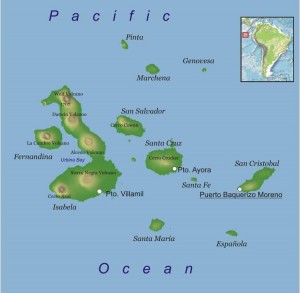
About one hundred years later in 1934, Ecuador passed the first legislation making the Galapagos Islands a protected area. In 1959, legislation established the Galapagos National Park, which commenced operations in 1968. Park jurisdiction covers 97 per cent of the territory, with the remaining 3 per cent encompassing populated areas.
American awareness of the Galapagos Islands became more pronounced between 1942 and 1947 when the United States established an air base on Baltra Island as part of the defense strategy to protect the Panama Canal. Baltra was a great place to build an air strip, but the island had no water. No matter. Americans brought water across from nearby San Cristobal Island.
Silver Galapagos
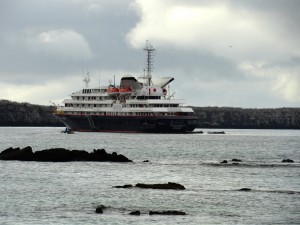
Our vessel was the Silver Galapagos operated by Silversea Cruises. The ship carries 100 passengers, 75 crew members, and displaces 4,077 tons. Fresh from her latest refurbishment, the officers and crew welcome new guests with champagne before snapping their identification picture.
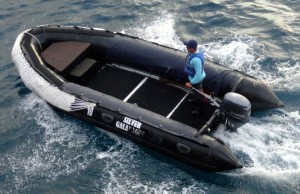
Flights to the Galapagos Islands land at an airstrip on Baltra Island. Visitors then go through Galapagos immigration, pay the Galapagos National Park Entrance Fee ($US100, cash, unless other arrangements have been made), and proceed into a wonderland Walt Disney never imagined. Silversea took care of all fees and transfers.
From the airport, we boarded a bus that took us to a zodiac landing area. This was the first of many zodiac transfers. At no point did the Silversea Galapagos come alongside an actual dock. This was termed a “dry landing” because passengers boarded from a firm cement platform rather than the beach. (More on that another time.)
So, picture a busload of people who’ve never met getting their first look at their transportation. Crewmembers deftly got folks into life jackets and the small vessel, motored it across fairly calm water, and pulled up to the area for boarding the ship. Passengers were handed up onto a small platform and then climbed a short ladder to the deck. Trust me, we all felt entitled to that champagne.
Genovese Island
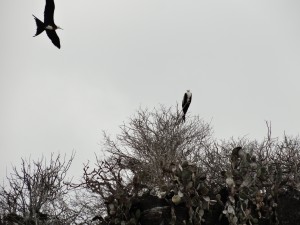
The first stop on our cruise around the North Central islands was Genovesa Island, more popularly known as Bird Island. I must be honest. I like birds. They are amazing creatures. But it wasn’t until I visited Genovesa Island that I understood the dedication of die-hard “birders.” The birds were completely oblivious to their gawking observers.
Swallow-tailed Gulls
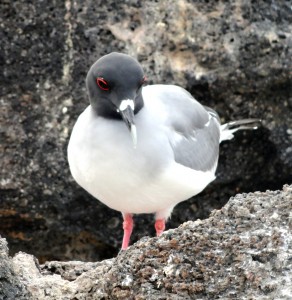
Swallow-tailed gulls nest almost exclusively in the Galapagos Islands. The birds are pelagic hunters, meaning they fly out over open ocean. These gulls are unique, because they feed nocturnally on fish and squid eating plankton at the ocean’s surface.
Nazca Booby
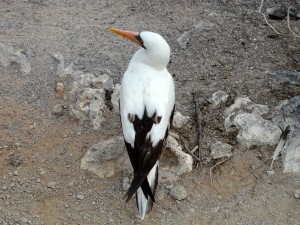
There are three types of booby birds in the Galapagos: Red-footed Boobies, Blue-footed Boobies, and Nazca Boobies. Nazca Boobies are the largest of the three.
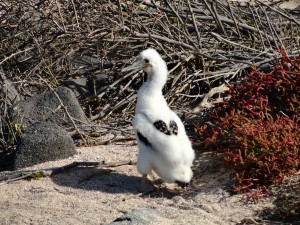
Red-footed Booby
The Red-footed Booby is the smallest of the three. Like their Nazca cousins, Red-footed boobies forage at sea for food. They catch flying fish by skimming the ocean surface and catching the fish before they can splash back into the water. Red-footed boobies build their nests in trees. Each couple lays one egg.
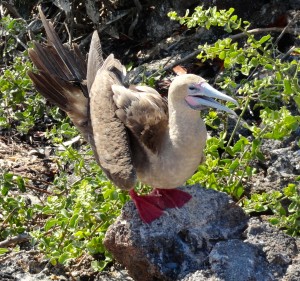
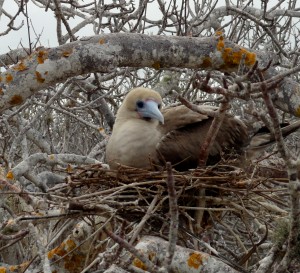
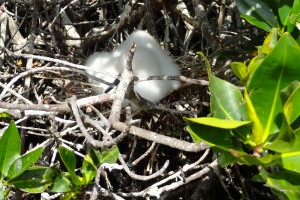
Blue-footed Booby
Blue-footed boobies are found near all the islands and remain close to shore. Blue-footed boobies have an elaborate mating ritual, and I was fortunate to watch part of it. The male dances to attract the female. He raises one foot in the air, then the other and sort of struts in front of the female. Both birds stretch their necks and point their bills upward. In the sequence below, the male gave the dance his full effort, and the female seemed interested. But she pulled back, and he gave up by flying away. Did they get back together? Who can say?
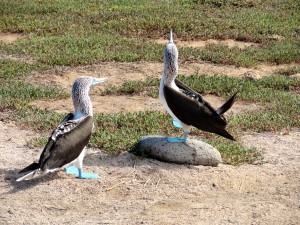
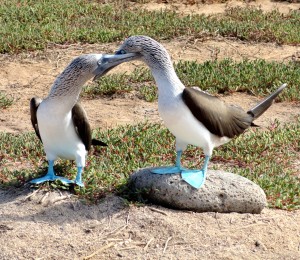
Frigate Birds
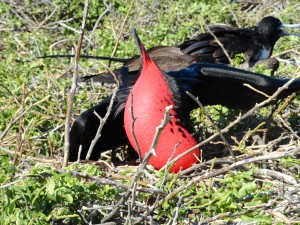
Frigate birds follow a different mating ritual.
Male frigate birds, like the one above, have red throat pouches, which they inflate in a effort to attract females.
The day spent on Genovesa Island was magical, but it was only the first day of my Galapagos Cruise. More images next week.
Acknowledgements:
Featured Image: Visitors are only allowed on clearly marked trails. In case the “Stop” sign was not enough, there was also a guard bird.
Photos by Author. All Rights Reserved.
Map of the Galapagos Islands from Freeworldmaps.net, Creative Commons Share Alike, Wikimedia Commons
Parque Nacional Galapagos Ecuador Here.
Silversea Cruises. Here.

Sandra Wagner-Wright holds the doctoral degree in history and taught women’s and global history at the University of Hawai`i. Sandra travels for her research, most recently to Salem, Massachusetts, the setting of her new Salem Stories series. She also enjoys traveling for new experiences. Recent trips include Antarctica and a river cruise on the Rhine from Amsterdam to Basel.
Sandra particularly likes writing about strong women who make a difference. She lives in Hilo, Hawai`i with her family and writes a blog relating to history, travel, and the idiosyncrasies of life.


Dear Sandra,
What fun I am having reading your pieces from on the road to and at Machu Picchu, and now in the Galapagos Islands. What you do so well is make it seem like a walk out the front door. It is very helpful that you provide all the contacts and links if one were as intrepid as you and the ‘Handsome Bloke’, and your photographs are wonderfully colorful and add much, too.
Why do I connect your name to Lowell Thomas?
Aloha,
David
I’m so glad you’re enjoying the blog. More adventures still to come.